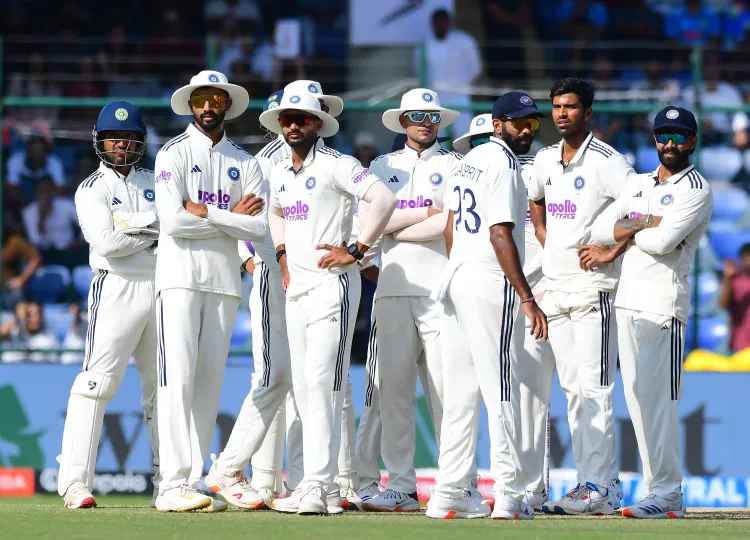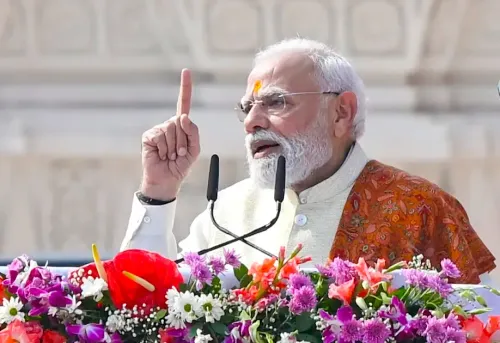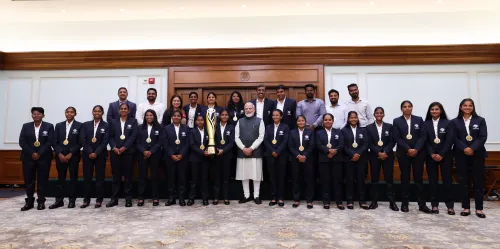Was India's Decision to Enforce the Follow-On Right?

Synopsis
Key Takeaways
- India's decision to enforce the follow-on raised questions about strategy.
- The pitch conditions became increasingly challenging for bowlers.
- Ten Doeschate highlighted the importance of tactical patience.
- Player development must align with team strategy and winning objectives.
- A focus on pace variation can lead to mistakes from the opposition.
New Delhi, Oct 12 (NationPress) One might have expected that after the West Indies were dismissed for 248 on the third day of the second and final Test, India would opt against enforcing the follow-on. Instead, the hosts decided to bat again on a slower pitch that still appeared favorable for batting, allowing their bowlers some necessary respite.
However, India enforced the follow-on and, despite claiming the first two wickets swiftly, found themselves struggling to secure additional breakthroughs. This was largely due to a determined counter from John Campbell and Shai Hope, who scored 87 and 66 runs respectively. The West Indies still need 97 runs to force India to bat again, leading to speculation about whether India should have opted to bat instead.
Ryan ten Doeschate, India's assistant coach, acknowledged that there was a conversation regarding batting again. They ultimately decided against it, citing their substantial 270-run lead. However, as ten Doeschate pointed out, the pitch continued to slow down, making it increasingly difficult for the Indian bowlers to make further inroads, as Campbell and Hope formed an unbroken 138-run partnership.
“We discussed the possibility of batting again. The last two wickets took longer than anticipated, which made us consider that option. However, we believed that a 275-run lead was substantial and thought the pitch would deteriorate further. By wrapping up the West Indies' innings, we thought we had overcome the worst of it. Yet, it seems the pitch has slowed even more,” he explained.
“It’s challenging to generate pace, and you must be prepared to deliver the ball with precision. When the ball is delivered with pace, the chances of it spinning reduce. This afternoon proved tricky for us, with Campbell performing exceptionally well. We’ll regroup tomorrow, refine our strategies, and aim to dismiss the remaining batters to secure the win,” he stated during the post-match press conference.
Looking forward to the fourth day's play, ten Doeschate emphasized the need for tactical patience and varying pace from the bowlers to induce mistakes from the visiting batsmen.
“It’s a mental adjustment. We want to maintain speed; it’s our most flexible approach. Whenever they bowled slightly slower, they achieved more turn, giving the batter more time. Striking the right balance and using pace variations will be crucial to force errors,” he added.
“Patience is key. Campbell played exceptionally well, which presents another tactical consideration. We sometimes expect too much from our bowlers, especially when the pitch isn’t responsive. Credit goes to the West Indies for their resilience today,” he remarked.
Ten Doeschate also clarified the rationale behind not giving Kuldeep Yadav, who took 5-82 in the first innings, the new ball after enforcing the follow-on. The decision was based on selecting a bowler who could maximize the new ball’s hardness, leading captain Shubman Gill to award it to Ravindra Jadeja instead.
“To be candid, the decision was influenced by the ball's hardness. Kuldeep was effective at extracting spin towards the end of the first innings, but we believed one of the finger spinners could better utilize the new ball. We opted for someone who might achieve more grip or create opportunities if the batsman edged it,” he explained.
“Washi was also considered. We deliberated between Kuldeep and Washy regarding who should take the new ball, but Shubman opted for Jadeja to start the second innings,” he added.
Interestingly, seam-bowling all-rounder Nitish Kumar Reddy has had limited participation in the match, particularly with no bowling so far, despite discussions in pre-match conferences about his development for challenging overseas assignments.
Further scrutiny arose when Yashasvi Jaiswal’s part-time leg-spin was utilized instead of Nitish’s seam bowling for the final over of day three. Ten Doeschate stated that team strategy takes precedence over individual development when aiming to win a Test match.
“I’m not surprised. To clarify, we strive to balance player development with our objective of winning Test matches. Winning is our top priority. We first assess who the best bowler is for the situation. If feasible, we adjust roles to optimize our strategy,” he explained.
“In terms of tomorrow, having bowled only four overs in this series and just one genuine opportunity to bat isn’t ideal for Nitish. Nevertheless, strategy remains paramount over individual development,” he concluded.









